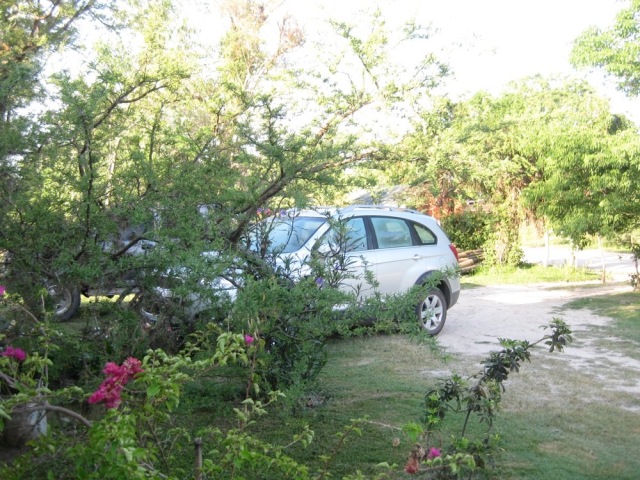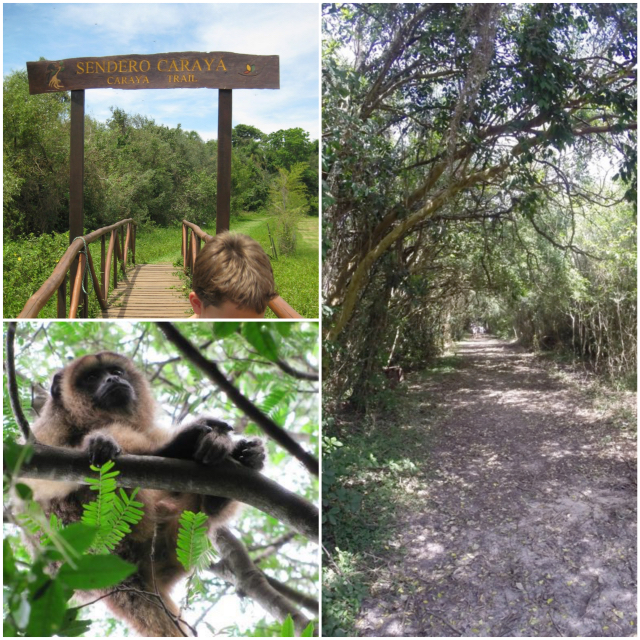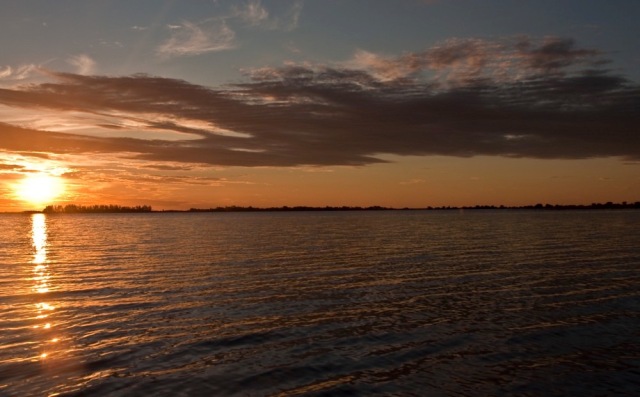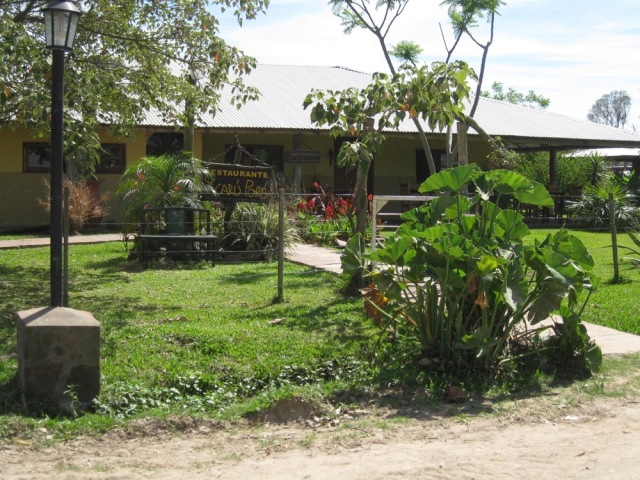When traveling to Argentina, it’s really worth a detour to Corrientes province, to visit its well-hidden natural wonder: Esteros del Iberá.
This impressive natural reserve of over 2.000.000 square kilometers is a group of lagoons, marshlands and swamps, which are home for a huge variety of plants, animals, insects, butterflies…. The area is of a pure, unrivalled beauty.
 Esteros del Ibera air view. A green paradise…
Esteros del Ibera air view. A green paradise…
One of the reasons why this area is so well protected is its difficult access, only possible by 4×4 vehicles. The gateway to explore Ibera wetlands is a little rural village named Colonia Carlos Pellegrini. When coming from the town of Mercedes, you will need to go through 120 -endless- kilometers of unpaved road in a very bad condition. It is not a good idea to attempt it with a regular car: there are many chances you will get stuck, literally in the middle of nowhere!
 Road to Colonia Carlos Pellegrini. Drive carefully, be patient and enjoy the ride!
Road to Colonia Carlos Pellegrini. Drive carefully, be patient and enjoy the ride!
Even if the road is difficult, we enjoyed it a lot, and we were traveling with our kids! (long trips with kids, many of you know what I’m talking about…). Besides the feeling of adventure, we were getting already a taste of what we would see at the wetlands, as wild animals started showing up: capybaras, ñandúes, armadillos…And when it became dark, we were delighted: thousands of fireflies everywhere! It was just magic!
 Wild animals on the road to Colonia Carlos Pellegrini: ñandú and a nine-banded armadillo
Wild animals on the road to Colonia Carlos Pellegrini: ñandú and a nine-banded armadillo
When arriving to Colonia Carlos Pellegrini, a very narrow -somewhat scary- bridge welcomes you; it was built by the Argentinian army in 1970.
 Welcome to Colonia Carlos Pellegrini!
Welcome to Colonia Carlos Pellegrini!
The town is an invitation to relax, an absolute stress detox from the frenetic rhythms of civilisation… Don’t expect crazy nightlife or happenings: it’s just you and nature… Roads are unpaved, trees and flowers everywhere; the only noise you hear is birds singing.
 Nature at its best: few vehicles, flowers and birds singing…
Nature at its best: few vehicles, flowers and birds singing…
After a restful sleep at our posada, we headed early morning for a boat ride in the wetlands. Our guide, Jorge, was telling us in the meantime some interesting information about the history of Esteros del Ibera: the area was declared National Reserve in 1983; in an effort to limit poaching (very common back then), many hunters became Reserve guards (smart move!).
 A boat ride to the wetlands is a must. Our guide and driver, Jorge
A boat ride to the wetlands is a must. Our guide and driver, Jorge
Our first stopover is the Centro de Interpretación (Interpretation Center), where a guard registers our boat. For ecological reasons, only a limited number of boats are allowed…
 Centro de Interpretación, Esteros del Ibera
Centro de Interpretación, Esteros del Ibera
Then we start admiring the lush vegetation: water hyacinths and poppies, aquatic nettles, bulrushes and cannas which give rise to the phenomenon of embalsados: authentic floating islands, so dense that they grow on land species, such as shrubs and even trees…
 Esteros del Ibera’s embalsado; the water hyacinth is the most common species
Esteros del Ibera’s embalsado; the water hyacinth is the most common species
The wetlands are the habitat of a huge number of birds (see below). An interesting bird species is chajá (southern screamer): chajás are monogamous, once a couple they no longer separate. It is popularly believed that if one of them dies, the other one dies of sadness shortly after… The couple also shares the eggs’ incubation (!)
 A couple of chajás. Their behaviour, an example to be followed by humans…
A couple of chajás. Their behaviour, an example to be followed by humans…
After that, we get to see the king of the swamps: the yacaré! Both yacaré negro (the most commonly found) and yacaré overo (they are a variety of caymans) can reach over two meters long, but due to intense poaching before the foundation of the park and their slow growth you will rarely see so big ones. The latest years, though, they have been able to reproduce and they are easily spotted.
It’s very common to see them with a huge, open mouth. That doesn’t mean they are about to eat us! Like all reptiles, yacares don’t control their body’s temperature, they depend on external conditions. When the temperature begins to rise, opening their mouth is the mean to cool themselves! Yacarés in fact eat mainly fishes such as palometa, a species of piranha (yes, there are piranhas at the wetlands, don’t get tempted to swim there…).
 The impressive yacare negro “cooling down” at an embalsado…
The impressive yacare negro “cooling down” at an embalsado…
Our guide Jorge turns off the engine of the boat, and with the rows gets really close to them:
 A yacare close-up. In spite of the scary look, they won’t attack unless they feel threatened…
A yacare close-up. In spite of the scary look, they won’t attack unless they feel threatened…
Another easily spotted animal is carpincho (capybara), the largest rodent in the world. Carpinchos are very social, they are usually seen in groups of 10-20. Their gestation lasts only 4 months, and they can have up to 8 pups in a single litter, that explains why there are so many of them…
 Carpincho, the world’s largest rodent
Carpincho, the world’s largest rodent
Our 2-hour boat ride finishes…. After some rest to recover from the heat, we spend some time at the Centro de Visitantes (Visitor’s center). The center has an interesting exhibition hall with illustrative material on history, geography and biology of the Reserve.
 Visitor’s Center “Bright Water”, Reserve of Ibera
Visitor’s Center “Bright Water”, Reserve of Ibera
From there we head to Sendero Caraya (Caraya trail), a beautiful walk in the middle of the forest, where, if you are lucky enough, you will see caraya monkeys. These monkeys commonly sleep up to 70% of the day!, and they are quite shy, so they may not be seen if there are a lot of people around…
 Caraya trail, one of the numerous trails you can take to admire wildlife…
Caraya trail, one of the numerous trails you can take to admire wildlife…
You may see as well ciervos de los pantanos (marsh deers)… Marsh deers are excellent swimmers, usually solitary animals. They are considered an endangered species.
 Ciervos de los pantanos (marsh deers)
Ciervos de los pantanos (marsh deers)
Other activities
Bird Watching: If you like bird watching, this is your spot! There are more than 350 species of birds at Ibera Wetlands. Special tours are organised for that purpose; most of the lodges will be able to arrange one for you.
 You will be able to see plenty of birds, even if you don’t go birdwatching…
You will be able to see plenty of birds, even if you don’t go birdwatching…
Sunset and night boat ride: if you have enough time, it is a good idea to take a boat ride to see the sunset at the lagoons. There you will realise why the place is called Ibera: in guarani (the language of the indians who used to live there) it means “bright water”… Night navigation offers the possibility of spotting animals that during the day are hiding from the harsh sun: armadillos, foxes, vizcachas, owls…
 Ibera lagoon at sunset. “Bright water” as the indians named the area…
Ibera lagoon at sunset. “Bright water” as the indians named the area…
Horseback rides: with the guide of wildlife specialists, you can explore more remote areas and get to know their flora and fauna in detail…
 Horseback riding tours at Rancho de los Esteros
Horseback riding tours at Rancho de los Esteros
USEFUL TIPS
How to get there: there are only 2 roads to get to Colonia Carlos Pellegrini, both unpaved!: from Mercedes, Corrientes (120 km, of which 80 km unpaved; you will follow this one if you come from Buenos Aires); or from Posadas, Misiones (250 km, of which about 150 km unpaved)…
- Access in only by 4×4. Unless you come on an organised tour, you can hire them at Mercedes.
- If you drive your own vehicle, don’t forget to get some gas in Mercedes, there is no gas station afterwards!
- Another important tip: there are chances that, in case of heavy rain, you get stuck at Carlos Pellegrini; keep that in mind in case you have a plane to catch…
When to go: The ideal period to visit Esteros del Ibera is from March to October. Summer gets really hot and humid!
Where to stay: Ibera has seen lately some touristic development; you can find there several lodges and posadas of all ranges, from luxury to more modest. Most of them have air condition and wifi. There is also a camping.
 Some of the lodges at Carlos Pellegrini: Posada el Yacare, Posada de la Laguna, Irupe Lodge
Some of the lodges at Carlos Pellegrini: Posada el Yacare, Posada de la Laguna, Irupe Lodge
Where to eat: there are a few restaurants where you can taste Argentina’s traditional dishes. Try the very nice, family-own Yacaru Pora.
Photo credits
All photographs belong to woman2womenblog.com, except for the following:
Ibera air view: Wikimedia commons; nandu: collet-trust.org; armadillo: Wikimedia commons; bridge: ibera.gov.ar, iberawild.com.ar; caraya monkey: tripadvisor.com; Ibera sunset: Wikimedia commons; horseback ride: ranchodelosesteros.com.ar; Where to stay: Posada el Yacare, Posada de la laguna, Irupe Lodge.




Nice virtual tour! So far so nice for me 🙂 Thanks for sharing. Bye. Kamila
LikeLiked by 1 person
Thank you for your comment! Esteros del Ibera is one of those places that is (still) a hidden treasure, and definitely worths a visit…
LikeLike